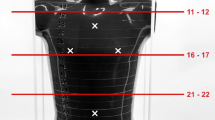Abstract
Independent verification of transit time and the methodology employed in commercial high dose rate (HDR) afterloaders to compensate its effect is an important part of their commissioning and quality assurance. This study aimed to independently evaluate the Co-60 source transit time of the new BEBIG SagiNova® HDR afterloader unit by employing a dosimetric approach using a well-type ionization chamber. The source was placed at three dwell positions (DPs) to mimic a variety of clinical situations with different distances from the afterloader unit. The distances of the DPs to the afterloader were 129.37 cm, 124.50 cm and 118.57 cm. Plans were generated using the SagiPlan® treatment planning system to produce 3, 5, 10, 15, 20, 30, 40, 60 and 120 s dwell times (DTs). The residual transit times (following any possible system compensation) were assessed using the ESTRO-recommended approach of obtaining transit time compensation factors and another strategy established for teletherapy sources. The mean residual transit time depended on the distance between the afterloader and the DP, ranging from 0.43 to 1.10 s. The transit dose contribution was case-specific, ranging from 0.4% for a 60 s DT at the nearest DP to the afterloader up to 15.6% for a 3 s DT at the furthest DP from the unit. The results show that currently SagiNova® afterloader does not apply transit time compensation and suggest a 0.2–0.5 s compensation for each arrival and departure DP from/to the afterloader, depending on position in an 11 cm active length.


Similar content being viewed by others
References
Giménez-Alventosa V, Vijande J, Ballester F, Perez-Calatayud J (2016) Transit dose comparisons for 60Co and 192Ir HDR sources. J Radiol Prot 36(4):858
Wong TP, Fernando W, Johnston PN, Bubb IF (2001) Transit dose of an Ir-192 high dose rate brachytherapy stepping source. Phys Med Biol 46(2):323
Palmer A, Mzenda B (2009) Performance assessment of the BEBIG MultiSource® high dose rate brachytherapy treatment unit. Phys Med Biol 54(24):7417
Venselarr J, Perez-Calatayud J (2004) European guidelines for quality assurance in radiotherapy, ESTRO Booklet No 8. A practical guide to quality control of brachytherapy equipment. ESTRO, Belgium, pp 1–270
Fonseca G, Rubo R, Minamisawa R, Dos Santos G, Antunes P, Yoriyaz H (2013) Determination of transit dose profile for a 192Ir HDR source. Med Phys 40(5):51717
Palmer A (2013) Impact of software changes: transit dose and source position accuracy of the Eckert & Ziegler BEBIG GmbH MultiSource® high dose rate (HDR) brachytherapy treatment unit. J Radiother Pract 12(1):80–87
Fonseca GP, Viana RS, Podesta M, Rubo RA, Sales CP, Reniers B, Yoriyaz H, Verhaegen F (2015) HDR 192Ir source speed measurements using a high speed video camera. Med Phys 42(1):412–415
Dempsey C, Smith R, Nyathi T, Ceylan A, Howard L, Patel V, Das R, Haworth A (2013) ACPSEM brachytherapy working group recommendations for quality assurance in brachytherapy. Australas Phys Eng Sci Med 36(4):387–396
Fonseca G, Landry G, Reniers B, Hoffmann A, Rubo R, Antunes P, Yoriyaz H, Verhaegen F (2014) The contribution from transit dose for 192Ir HDR brachytherapy treatments. Phys Med Biol 59(7):1831.
Sahoo N (2001) Measurement of transit time of a remote after-loading high dose rate brachytherapy source. Med Phys 28(8):1786–1790
Jursinic PA (2014) Quality assurance measurements for high-dose-rate brachytherapy without film. J Appl Clin Med Phys 15(1):246–261
Jeong J, Barker CA, Zaider M, Gil'ad NC (2016) Impact of source position on high-dose-rate skin surface applicator dosimetry. Brachytherapy 15(5):650–660
Minamisawa R, Rubo R, Seraide R, Rocha J, Almeida A (2010) Direct measurement of instantaneous source speed for a HDR brachytherapy unit using an optical fiber based detector a. Med Phys 37(10):5407–5411
Mukwada G, Neveri G, Alkhatib Z, Waterhouse DK, Ebert M (2016) Commissioning of a well type chamber for HDR and LDR brachytherapy applications: a review of methodology and outcomes. Australas Phys Eng Sci Med 39(1):167–175
Wilkinson D (2006) High dose rate (HDR) brachytherapy quality assurance: a practical guide. Biomed Imaging Interv J 2(2):e34
Podgorsak EB (2005) Radiation oncology physics. International Atomic Energy Agency, Vienna, pp 123–271
Kim Y, Modrick JM, Pennington EC, Kim Y (2016) Commissioning of a 3D image-based treatment planning system for high-dose-rate brachytherapy of cervical cancer. J Appl Clin Med Phys 17(2):405–426
Supe SS, Bijina T, Varatharaj C, Shwetha B, Arunkumar T, Sathiyan S, Ganesh K, Ravikumar M (2009) Optimized dose distribution of Gammamed plus vaginal cylinders. J Med Dosim 34(1):20–25
Oyekunle EO, Obed RI, Akinlade BI, Ntekim A (2015) Comparison of doses to the rectum derived from treatment planning system with in-vivo dose values in vaginal vault brachytherapy using cylinder applicators. J Contemp Brachytherapy 7(6):485
Nag S (2004) High dose rate brachytherapy: its clinical applications and treatment guidelines. J Technol Cancer Res Treatment 3(3):269–287
Acknowledgements
The authors would like to thank Eckert & Ziegler BEBIG GmbH for helpful information, in particular, Antonius Spiller, Thomas Osche and Lars Flemmig for their valuable comments on the manuscript.
Funding
This study was funded by Shiraz University of Medical Sciences (Grant No. 97-07-75-18167).
Author information
Authors and Affiliations
Corresponding author
Ethics declarations
Conflict of interest
The authors declare that they have no conflict of interest.
Ethical approval
This article does not contain any studies with human participants or animals performed by any of the authors.
Additional information
Publisher's Note
Springer Nature remains neutral with regard to jurisdictional claims in published maps and institutional affiliations.
Rights and permissions
About this article
Cite this article
Kanani, A., Karbasi, S. & Mosleh-Shirazi, M.A. Independent assessment of source transit time for the BEBIG SagiNova® cobalt-60 high dose rate brachytherapy afterloader. Australas Phys Eng Sci Med 42, 913–919 (2019). https://doi.org/10.1007/s13246-019-00788-9
Received:
Accepted:
Published:
Issue Date:
DOI: https://doi.org/10.1007/s13246-019-00788-9




